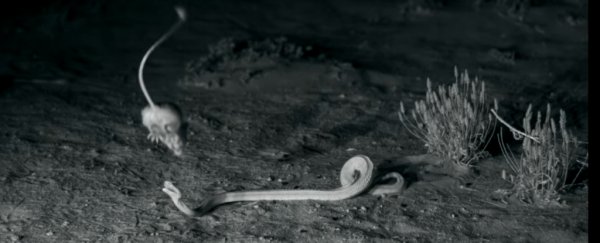Forget mutant turtles. Kangaroo rats are the true ninjas of the animal kingdom.
A series of four high-speed videos has recently captured these little fighters flipping and kicking in mid-air as they artfully dance around their arch nemesis, the hungry sidewinder rattlesnake (Crotalus cerastes).
It's a battle between two extreme athletes, and the result is a lightning fast interaction, swifter than the blink of an eye.
Using high‐speed video recordings, we can now see clearly, for the first time, how these incredible manoeuvres keep desert kangaroo rats (Dipodomys desert) alive and kicking.
Of the 32 strikes recorded from 13 snakes, the authors found that only 15 resulted in a venomous bite, and only seven were fatal.
With 17 misses, only eleven were considered accurate strikes, mostly avoided through a quick jump on the kangaroo rat's part. In a few cases, however, the rat had to contort its body in mid-air so that the snake did not make contact - the rats were captured flipping upside down, swinging their hindquarters away, or retracting their head from the snake.
"Kangaroo rats that responded quickly were frequently able to jump clear of the snake completely, leaving the serpent biting nothing but dust as the kangaroo rat rocketed 7-8 body lengths into the air," says co-author Rulon Clark, a biologist at San Diego State University.
The authors think this is because kangaroo rats have enlarged auditory bullae - hollow, bony parts of the inner ear - which let them perceive the almost noiseless movement of an ambushing snake or an owl.
"Additionally, the hindlimbs of kangaroo rats appear to be specialised for explosive leaps that can rapidly propel them out of the attack trajectory of a predator," the authors write.
Put together, these two physical advantages allowed some kangaroo rats to initiate their jumps within just 38 milliseconds of a snake starting its strike.
Still, even when the rats were not fast enough to contort and escape their predators' clutches, these creatures had another trick up their sleeves - one the authors did not see coming.
"They often were able to avoid being envenomated by reorienting themselves in mid-air and using their massive haunches and feet to kick the snakes away, ninja-style," explains Clark.
In one instance, the kangaroo rat flipped onto its back, used its hindlegs to kick the rattlesnake's head away, and then used its own tail to rotate back upright and leap away, all in under 250 milliseconds.
While the authors admit it's impossible to say whether this was an accidental move, their impression is that these are "coordinated and directed defensive manoeuvres performed with extreme speed."
"If so," the authors explain, "then these remarkable avoidance behaviours indicate that kangaroo rats are not only capable of perceiving an oncoming snake strike and responding rapidly but can also process enough information about the snake to use alternative defensive manoeuvre behaviours other than just leaping."
All in all, the study found that the snakes only released three kangaroo rats of their own accord - once they had sunk their teeth into them, that is. The other dozen rats removed themselves from the snakes, by kicking or contorting.
According to the authors, this is the first direct evidence that some prey can remove snakes they've already been bitten by, thus increasing their chances of survival.
As incredible as this footage is, however, it tells us nothing about the underlying physiology. That will need to be elucidated in further research.
For now, all we can do is marvel at these little ninjas.
This study has been published in Functional Ecology.
